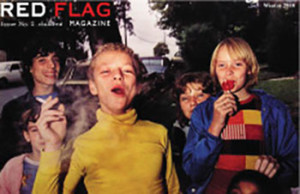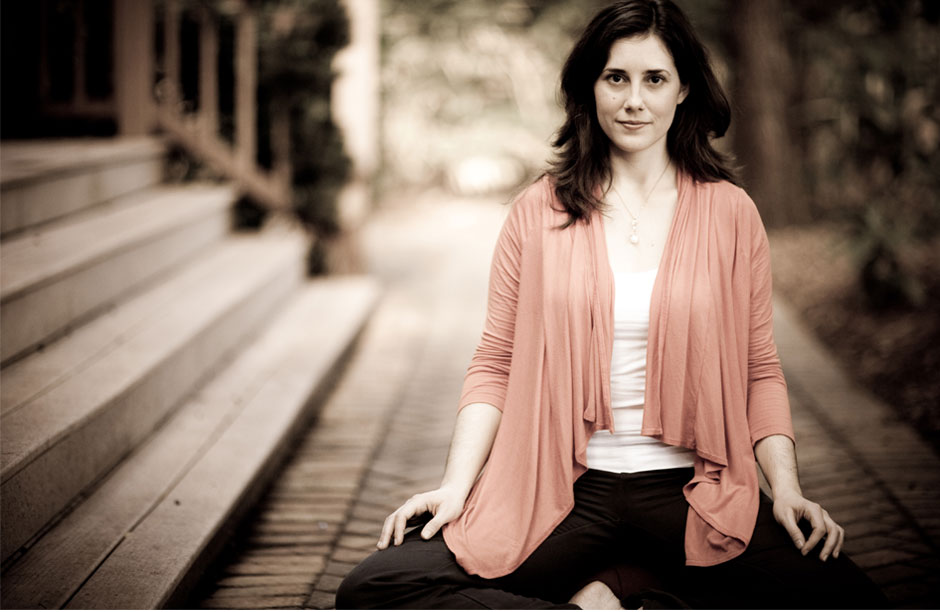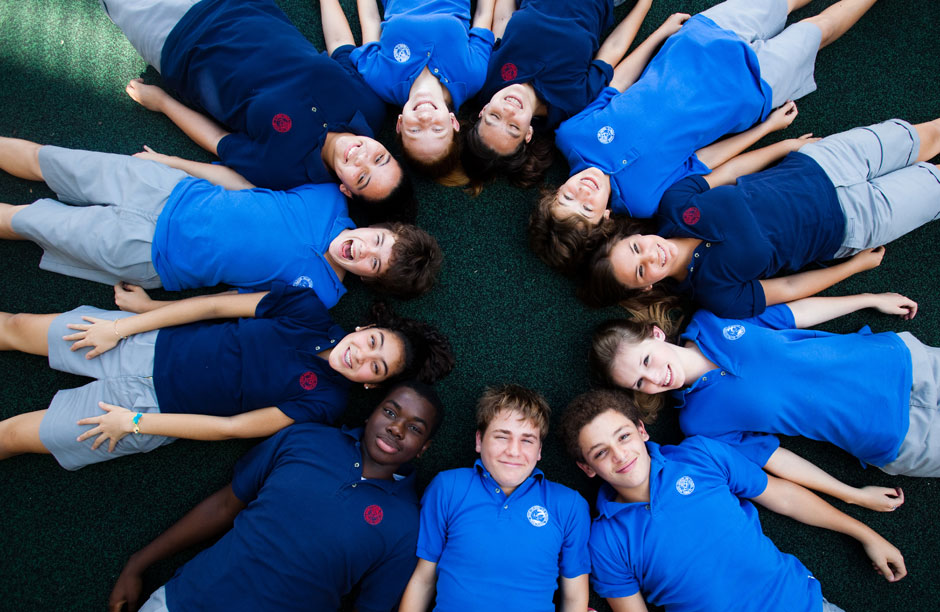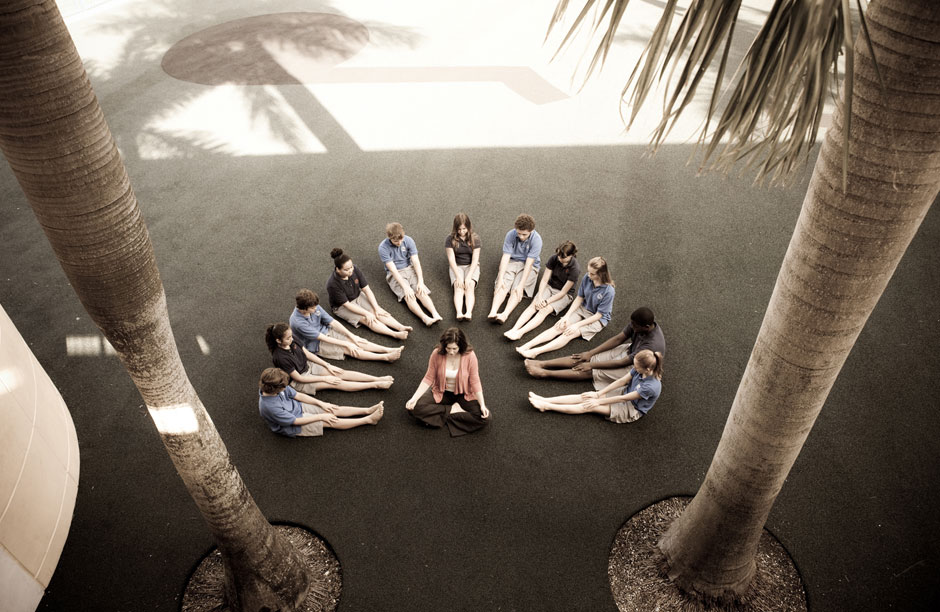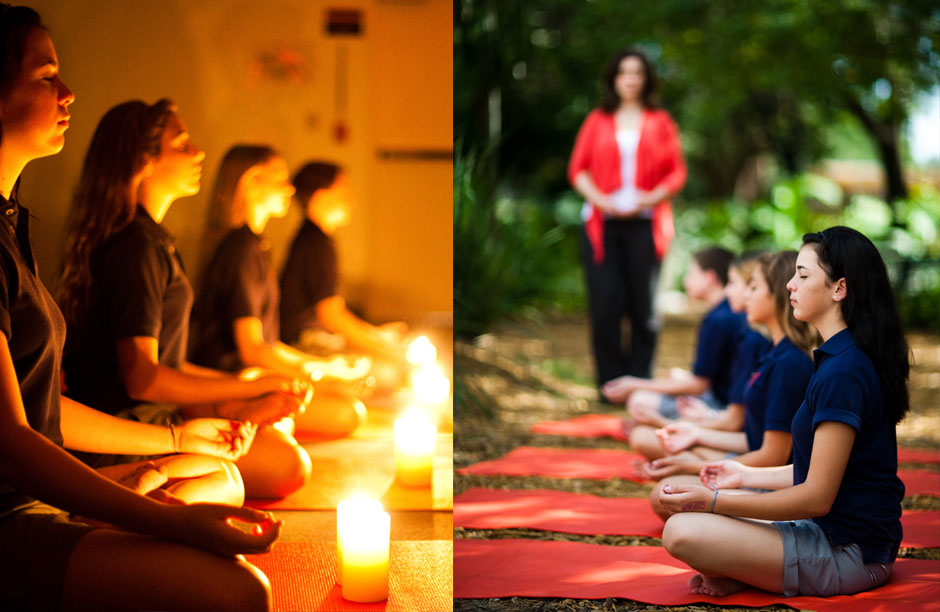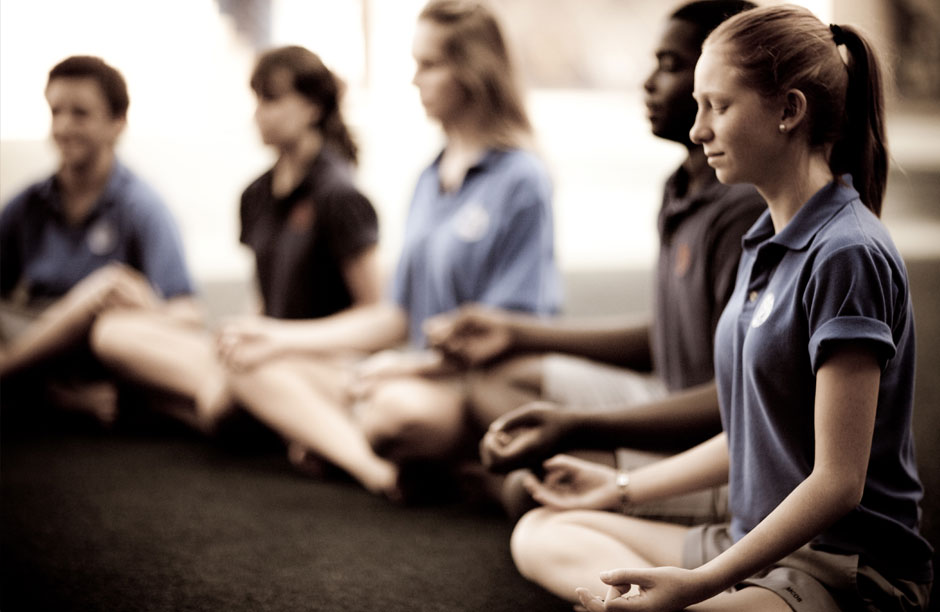Chaos to Calm: Using Mindfulness with Middle School Students
By Shelly Sowell
A chime sounds. The laughter of children slows to a quiet calm as the rustling of bodies in chairs stills and the only sound heard is the pulsing breath of children as they begin the school day with a moment of peace. This is beautifully serene, but this is not middle school, at least not the two hundred 7th and 8th graders that I teach on a weekly basis.
In my world, the school bell shrieks, within seconds classroom doors fly open and slam against the wall as backpacks propel through the air. Depending on the time of day and how much sugar has been ingested, the children bring either a loud burst of hyper-excited energy or a sluggish solemn tired energy, indicative of too little sleep and too many activities. The cacophonous chatter rises and falls as children slink into their chairs talking openly about their day, usually a mix involving grades, homework, gossip and plans for the weekend. After using my newly acquired teacher voice firmly asking them to give me their attention, I shift into a more rhythmic tone, “Become comfortable in your chair and gently begin your process of bringing awareness to your breath.” Eyes begin to close as they attempt to still their bodies and shift their awareness inward. “Feel the breath moving through your body and begin to use your imagination to take whatever has happened in your day and whatever is to come, packaging it up and placing it outside of this place, bringing yourself into this moment.”
If you’ve ever attempted to teach meditation to middle school students, then you know there are 1,000 steps between the bell and the “break”. The “break” is the moment like a fever breaking into relief: the chairs stop moving, the pencils stop tapping, the hums, whispers and giggles stop sounding, the eyes stop wandering, the legs stop shaking – it is the moment the chaos finally gives and the students start to drop-in and connect. As a long time practitioner of mindfulness, a mental health counselor and now teacher, I am convinced dropping-in and connecting to their inner experience will save the lives of many of our children.
Right now, kids are in a crisis. They are growing up in a world that is changing faster than they are developing. The opportunities gained by advancements in technology, such as a globalized culture and more convenient, faster venues for communication, also present certain emotional and social challenges to children who are losing time for reflection and integration. As attention spans diminish, kids attempt to cope with internal and external pressures – easily accessible drugs and alcohol, highly sexualized images and violence in media, bullying, peer group concerns, divorce/family problems, and the list goes on.
In his book, The Mindful Brain, Dr. Daniel Siegel, Co-Director of the Mindful Awareness Research Center at UCLA, explains that the adolescent brain undergoes a natural process of “brain remodeling.” He asserts that stress can negatively impact this important neurological transition; however, reflective skills may help to strengthen the healthy development of the brain during this time.
While children are adapting to internal biological shifts, they are also surviving pervasive external cultural shifts. Dr. Nancy Carlsson-Paige, Professor of Early Childhood Education at Lesley University, has written extensively about the effects of consumerism and violence in media on children’s development. In her book, Taking Back Childhood, she explains how our consumer culture targets children and creates deficits in their “sense of self” as well as undermines authentic creativity and the ability to engage in and cultivate meaningful relationships.
The world seems stacked against our children, but we are by no means powerless in the situation. Mahatma Gandhi said, “If we are going to reach real peace in this world, and if we are going to carry on a war against war, we shall have to begin with the children.” I believe we start by addressing the wars within our youth, helping children to integrate their inner experiences, transform their difficult emotions into wisdom, and learn advanced skills for evolving as creative, intelligent, empathic and conscious human beings.
In the fall of 2007 I faced one of the biggest challenges of my professional life. With no background in teaching children, I agreed to instruct middle school life skills classes at an independent college preparatory school in Miami, Florida. There was not a set curriculum, only guidelines to cover social skills, substance abuse prevention, puberty and sexuality, stress management, etc. My training and years of experience as a mental health professional prepared me to treat anxiety, depression, trauma, grief, but nothing prepared me for facing 10 classes of 20 twelve-year-olds weekly. Thinking fast with my heart racing, the words, “just breathe” kept coming to mind. So I taught them a meditation . . . to buy me time, to slow them down, to create some space for witnessing rather than reacting to the moment of chaos. Surprisingly it worked, and I noticed that while tending to my own anxiety, we had dealt with theirs. Students were asking for “the quiet time” as I arrived the following week. Over the next few weeks I began to develop what I now call Mindfulness-Based Life Skills (MBLS).
Mindfulness is non-judgmental and compassionate awareness of the present moment, as well as acceptance of who we are in that moment. This is a tall order for adults, let alone tweens. The foundational concept of MBLS is that developing adolescents make more positive choices when they are confidently grounded in self-identity and able to name and deal with their emotions. Often children turn to substance use, early sexual activity or other unhealthy choices when they are unable to discuss, process and deal with the stress in their lives.
MBLS classes typically begin with an opening meditation and/or a mindfulness practice that helps introduce the topic for the day. Throughout these lessons, the students are asked to focus on breath, intention, practice, and process. Awareness of their breath and making contact with their bodies is the first step in deepening their experience. Then I ask them to set an intention or open to a vision that compliments the lesson to be later taught in the class. For example, before beginning a class on drugs and alcohol use, the students are led in a guided imagery meditation that focuses on nourishing and respecting their bodies.
After meditation and visualization, some students report feeling “warm” and “energized”; others report feeling “drained” or “tired” ….whatever the experience, we honor it. Mindfulness practices are not all about feeling relaxed and peaceful; they are about being fully in the moment, which helps to bring clarity to our lives. Empowerment comes from being able to accurately name how we are in the moment and, if needed, to then recognize a positive action we can take to better our selves or our situation. After every mindful practice we process our experience out loud as a class. This final step creates a depth of understanding by validating one’s experience in the presence of a community.
As their educator I have quickly learned to become as gracefully adaptable as they have proven to be. I remember spending hours on a beautiful self-esteem presentation, only to arrive and discover the students had attended a cancer awareness assembly. Rather than a stadium-seated powerpoint discussion, we sat in a circle on the floor and shared thoughts/feelings about cancer, hope, death and God. Through my own journey I’ve had many amazing opportunities to explore these profound topics and was able to hold a gentle non-reactive space for the kids as they muddled through a very heavy and profound discussion.
Out of all this, I take with me the stories the students share. Most students report using meditation to help calm their nerves before a test or to help them refocus when they are doing homework. There are, however, also poignant specific examples such as one student sharing about a difficult family situation: “Mindfulness helped me when my Dad was at the hospital and had a lot of trouble. I wasn’t as afraid.” Finally there are the results that bring tears such as a young lady who shared that she had started down a dangerous path of numbing her emotions with sexual behaviors. She told me that mindfulness helped her to reconnect with her body and her inner light; as a result, she promised that she would never allow herself to be used or to be pressured into anything that did not support her highest self.
Across North America a revolutionary movement is building around mindfulness in education. While there have been nationally published success stories of using mindfulness practices in schools, the movement is not without controversy. Larger questions abound regarding the role of educators in fostering spirituality in schools. While the separation of church and state protects our citizens from unwanted religious indoctrination, a culture was inadvertently created where any mention of a spiritual life in public schools became taboo. Linda Lantieri, long-time educator and author of Schools with Spirit, advocates for schools to contemplate ways to foster the growth of the students’ hearts and spirits in a way that honors, rather than violates, their beliefs and culture. Mindfulness in education is a natural fit for this challenge. While originating in many spiritual traditions, mindfulness practices are not a religion, and are easily adaptable for secular use. The issues/questions/journeys that arise from mindful awareness, or waking up to one’s life, are inherently of a spiritual nature; how we create meaning of our world, how we deal with suffering and transform our trials into wisdom, how we discover our path and purpose, how we interpret the interconnectedness between self, community and world – these are deeper dimensions of human experience. Using mindfulness approaches, teachers have the opportunity to facilitate this growth of spirit in each child and through that inner journey promote the compassion necessary to share this world in peace with other human beings.
Numerous established programs, such as the Inner Kids Foundation in Los Angeles and the Inner Resilience Program in New York provide teacher training for cultivating contemplative practices personally and professionally. Organizations such the Mindfulness in Education Network (MIEN) and the Garrison Institute serve as hubs for resources and all people involved in this movement.
The leaders of this movement are some of the most vibrant and compassionate people you will meet and they will stop at nothing to save and transform the lives of children. I have joined this movement to integrate mindfulness into education and have seen firsthand the profound transformations that can take place. My job is no longer a job – it is a passion to change the world one child and one breath at a time.
